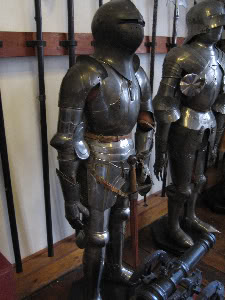I've been reading the forums for a while and I have learned quite a lot beyond the initial knowledge I had on medieval weapons and armour. My goal is to become a historian later in life, possibly focusing on the high middle ages in Europe. Although I spend most of my time researching the general history (military and otherwise) of the epoch, I have a particular interest in the history of technology and especially the development of armour. I wrote a college paper several years ago on the development of plate in the 14th century, but I have to say the collective knowledge on this board is far ahead of the information I had back then.
While traveling to Bahrain in 2006, we stopped over in Germany and spent a day driving along the Rhine visiting castles. I was particularly impressed by Marksburg and took a few photos, including some of the harnesses they had on display. The most interesting was a 15th century piece with a grand bascinet. In the background you can also see what I guess is a more stereotypical "gothic" harness, presumably of later make.

I'm not sure what the date of manufacture was, or even if the bascinet was originally part of the harness, as the finish looks a little different.

What is the likely period for this harness and the bascinet? If people are interested, I have other pictures available at higher resolution, but I didn't want to upload too much at once.